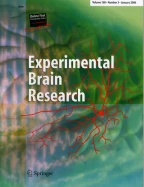Abstract
In real life situations large gaze saccades may involve rotations of the trunk, as well as the eyes and head. When this happens the rotation of the head-in-space is similar whether or not the trunk is also rotating. However, the rotation of the head on the trunk (i.e. the neck movement) is very different in the two circumstances. For similar head-in-space rotations to occur, the neck and trunk movements cannot simply add independently: they must be coordinated. It is argued that this is achieved via a feedback loop in which the semi-circular canals monitor the rotation of the head-in-space, and the neck is driven by an error signal representing the difference between the intended head-in-space trajectory and the actual trajectory. This mechanism, which is essentially the same as the vestibulo-collic reflex, nulls out disturbances to the head-in-space trajectory, whether these are caused by active or passive trunk rotation.
Similar content being viewed by others
References
Bailey NTJ (1959) Statistical methods in biology. Hodder & Stoughton, London
Ballard DH, Hayhoe MM, Li F, Whitehead SD (1993) Hand-eye coordination during sequential tasks. Phil Trans R Soc Lond B 337:337–339
Berthoz A (1991) Reference frames for the perception and control of movement. In: Paillard J (ed) Brain and space. Oxford University Press, Oxford, pp 81–111
Carpenter RHS (1988) Movements of the eyes. Pion, London
Guitton D (1992) Control of eye-head coordination during orienting gaze shifts. Trends Neurosci 15:174–179
Guitton D, Volle M (1987) Gaze control in humans: eye-head coordination during orienting movements to targets within and beyond the oculomotor range. J Neurophysiol 58:427–459
Guitton D, Kearney RE, Wereley N, Peterson BW (1986) Visual, vestibular and voluntary contributions to human head stabilization. Exp Brain Res 64:59–69
Guitton D, Bergeron A, Choi WY, Matsuo S (2003) On the feedback control of orienting gaze shifts made with eye and head movements. Prog Brain Res 142:55–68
Hayhoe M (2000) Vision using routines: a functional account of vision. Visual Cognition 7:43–64
Imai T, Moore ST, Raphan T, Cohen B (2001) Interaction of the body, head, and eyes during walking and turning. Exp Brain Res 136:1–18
Johansson RS, Westling G, Bäckström A, Flanagan JR (2001) Eye-hand coordination in object manipulation. J Neurosci 21:6917–6932
Kowler E, Pizlo Z, Zhu G, Erlekens CJ, Steinman RM, Collewijn H (1992) Coordination of head and eyes during the performance of natural (and unnatural) visual tasks. In: Berthoz A, Graf W, Vidal PP (eds) The head-neck sensory-motor system, Chap 65. Oxford University Press, Oxford
Land MF (1992) Predictable eye-head coordination during driving. Nature 359:318–320
Land MF (1993) Eye-head coordination during driving. Proc IEEE Systems Man and Cybernetics Conf, Le Touquet, vol 3, pp 490–494
Land MF, Lee DN (1994) Where we look when we steer. Nature 369:742–744
Land MF, Tatler BW (2001) Steering with the head: the visual strategy of a racing driver. Curr Biol 11:1215–1220
Land MF, Mennie N, Rusted J (1999) The roles of vision and eye movements in the control of activities of daily living. Perception 28:1311–1328
Morasso P, Bizzi E, Dichgans J (1973) Adjustments of saccade characteristics during head movements Exp Brain Res 16:492–500
Outerbridge JS, Melvill Jones G (1971) Reflex vestibular control of head movement in man. Aerospace Med 42:935–940
Pozzo T, Berthoz A, Lefort L, Vitte E (1991) Head stabilization during various tasks in humans. II. Patients with bilateral vestibular deficits. Exp Brain Res 85:208–217
Wilson VJ, Melvill Jones G (1979) Mammalian vestibular physiology. Plenum Press, New York
Zangemeister WH, Jones A, Stark L (1981) Dynamics of head movement trajectories: main sequence relationship. Exp Neurol 71:76–91
Acknowledgements.
I thank Julia Horwood for technical assistance with the Video analysis. Ben Tatler read and made valuable comments on the manuscript. This study was supported by a grant from the EPSRC (UK).
Author information
Authors and Affiliations
Corresponding author
Rights and permissions
About this article
Cite this article
Land, M.F. The coordination of rotations of the eyes, head and trunk in saccadic turns produced in natural situations. Exp Brain Res 159, 151–160 (2004). https://doi.org/10.1007/s00221-004-1951-9
Received:
Accepted:
Published:
Issue Date:
DOI: https://doi.org/10.1007/s00221-004-1951-9
